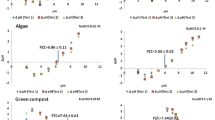Abstract
Electrokinetic remediation is one of the promising subsurface clean up techniques whose efficiency is directly affected by the zeta potential of clay minerals. To determine the factors affecting the zeta potential, in turn, electrokinetic remediation, the zeta potential of kaolinite is determined usingelectrophoretic mobility in the salt and heavy metals ions asfunctions of pH and concentration. The zeta potential of kaolinite ranged from -25 mV (pH 3) to -42 mV (pH 11) in water. The zeta potential of kaolinite became more negativewith increasing pH. The zeta potential of kaolinite was also found to be sensitive to the valence of ions. Results, furthermore, revealed that kaolinite has higher zeta potentialvalues in the presence of NaCl and LiCl than in water. However, the zeta potential of kaolinite decreased with divalent cationssuch as Ca2+ and Mg2+. The zeta potential of kaolinitewith heavy metal ions such as Cu2+, Co2+ and Pb2+ showed a similar trend, i.e., increase in the concentration ofthese ions caused a decrease in the zeta potential up to neutral pH, then it became positive. In highly basic environments, thezeta potential became negative again, giving two apparent pzcs. One of two apparent pzcs was attributed to kaolinite and the other one to the precipitation of these ions in highly basic solutions (pH ≥ 9).
Similar content being viewed by others
References
Bolloand, M. D. A., Posner, A. M. and Quirk, J. P.: 1976, ‘Surface charge on kaolinites in aqueous suspension’Aust. J. Soil Res. 14, 197-216.
Braggs, B., Fornasiero, D., Ralston, J. and Smart, R.: 1994, ‘The effect of surface modification by an organonasilane on the electrochemical properties of kaolinite’ Clay and Clay Minerals 42, 123-136.
çelik, S. M.: 2001, Personal communication.
Chorom, M. and Rengasamy, P.: 1995, ‘Dispersion and zeta potential of pure clays as related to net particle charge under varying pH, electrolyte concentration and cation type’ European J. Soil Sci. 46, 657-665.
Dillard, J. G. and Koppelman, M. H.: 1982, ‘X-ray photoelectron spectroscopic (XPS) surface characterization of cobalt on the surface of kaolinite’ J. Colloid Interface Sci. 87, 47-55.
Dzenitis, J. M.: 1997, ‘Soil chemistry effects and flow prediction in electroremediation of soil’ Environ. Sci. Technol. 37, 1191-1197.
Grundl, T. and Reese, C.: 1997, ‘Laboratory study of electrokinetic effects in complex natural sediments’ J. Hazard. Materials 55, 187-201.
Gu, Y. and Li, D.: 2000, ‘the ς-potential of glass surface in contact with aqueous solutions’ J. Colloid Interface Sci. 226, 328-339.
Holtz, R. D. and Kovacs, W. D.: 1981 An Introduction to Geotechnical Engineering, Prentice-Hall Inc., New Jersey, 733 pp.
Hotta, Y., Banno, T., Nomura, Y., Sano, S. and Oda, K.: 1999, ‘Factors affecting the plasticity of Georgia Kaolin Green Body. J. Ceramic Soc. of Japan 107, 868-871.
Lorne, B., Perrier, F. and Avouac, J.: 1999, ‘Streaming potential measurements 1. Properties of the electrical double layer from crushed rock samples’ J. Geophys. Res. 104, 17857-17877.
Mitchell, J. K.: 1993, Fundamentals of Soil Behavior, 2nd ed., John Wiley & Sons Inc., America.
Schroth, B. K. and Sposito, G.: 1997, ‘Surface charge properties of kaolinite’ Clays and Clay Minerals 45, 85-91.
Shang, J. Q.: 1997, ‘Zeta potential and electroosmotic permeability of clay soils’ Can. Geotech. J. 34, 627-631.
Smith, R. W. and Narimatsu, Y.: 1993, ‘Electrokinetic behaviour of kaolinite in surfactant solutions as measured by both the microelectrophoriesis and streaming potential methods’ Minerals Engineer. 6, 753-763.
Sondi, I., Biscan, J. and Pravdic, V.: 1996, ‘Electrokinetics of pure clay minerals revisited’ J. Colloid Interface Sci. 178, 514-522.
Sparks, D. L.: 1986, Soil Physical Chemistry, CRC Press, Boca Raton.
Sposito, G.: 1989, ‘Surface reactions in natural aqueous colloidal systems’ Schweizerischer Chemiker-Verband 43, 169-176.
Stephan, E. A. and Chase, G. G.: 2001, ‘A preliminary examination of zeta potential and deep bed filtration activity’ Seperat. Purific. Technol. 21, 219-226.
Vane, L.M. and Zang, G. M.: 1997, ‘Effect of aqueous phase properties on clay particle zeta potential and electr-osmotic permeability: Implications for electro-kinetic soil remediation process’ J. Hazard. Mater. 55, 1-22.
West, L. J. and Stewart, D. L.: 2000, ‘Effect of Zeta Potential on Soil Electrokinesis’ in The Proc. of Geoenvironment, ASCE, Boulder, CO, pp. 535-1549.
Williams, D. J. A. and Williams, K. P.: 1978, ‘Electrophoresis and zeta potential of kaolinite’ J. Colloid Interface Sci. 65, 79-87.
Yukselen, Y.: 2001, ‘A Study of Zeta Potential of Clay Minerals in the Presence of Various Chemical Solutions’ M.Sc. Thesis, Submitted to The Graduate School of Natural and Applied Sciences, Dokuz Eylul University, 82 pp.
Author information
Authors and Affiliations
Rights and permissions
About this article
Cite this article
Yukselen, Y., Kaya, A. Zeta Potential of Kaolinite in the Presence of Alkali, Alkaline Earth and Hydrolyzable Metal Ions. Water, Air, & Soil Pollution 145, 155–168 (2003). https://doi.org/10.1023/A:1023684213383
Issue Date:
DOI: https://doi.org/10.1023/A:1023684213383




